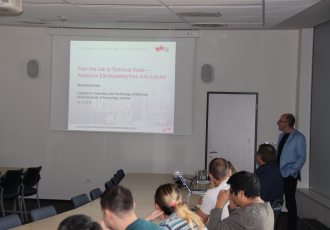- Speaker: Assoc. Prof. Dr. Bernhard Gollas
- Institution: Institute for Chemistry and Technology of Materials, Graz University of Technology, Austria
- Invited by: Ing. Michaela Remešová
- Date: 10.12. 2019
- Place: CEITEC Brno University of Technology
Anotation:
After several decades of intense research, room temperature chloroaluminate ionic liquids can now be considered a viable alternative to organic solvent-based alkyl-aluminum electrolytes for the commercial electroplating of aluminum [1]. While their possible use also includes electrochemical energy storage in secondary batteries [2], the development of chloroaluminate ionic liquid electrolytes was initially aimed at surface finishing [3], mainly for corrosion protection of steel. The properties of various combinations of Lewis acidic aluminum halogenides and Lewis basic organic halogenide salts have been established in numerous studies and the reaction mechanism of aluminum electrodeposition and dissolution has been explored, also by modeling [4]. In order to compete with the established SIGAL process [5], various aspects regarding the properties of the electroplated aluminum layers as well as practical issues of the plating process from chloroaluminate ionic liquids have to be addressed.
The morphology and structure of the aluminum layers correlate with their chemical and mechanical properties and must therefore be tailored to the respective application. Here, the current density and bath additives play a major role. Keeping in mind that the Lewis acidity of the electrolyte on the cathode surface has to be maintained, the limiting current can be maximized by adjusting the viscosity through co-solvents or temperature and by agitation of the bath. However, co-solvents as well as increased temperature might compromise the electrolyte stability [6]. Additives can be used as levelers, grain refiners, and/or brighteners. However, the highly reactive Lewis acidic mixture can severely limit their persistence and efficiency [7]. The pre-treatment of the substrate surface must be compatible with the water sensitive electrolyte and directly affects the adhesion of the electroplated layers. In addition, the post-treatment has to be adjusted to the reactive ionic liquid in order to maximize the layer quality.
These issues will be addressed in the talk showing examples from own work. Further aspects such as drag-out loss, bath maintenance, recycling, disposal, and cost, all relevant for a scale-up of the process, will be discussed.
[1] T. Tsuda, G. R. Stafford, and C. L. Hussey, J. Electrochem. Soc., 164, H5007 (2017).
[2] G.A. Elia, K. Marquardt, K. Hoeppner, S. Fantini, R. Lin, E. Knipping, W. Peters, J.‐F. Drillet, S. Passerini, and R. Hahn, Adv. Mater, 28, 7564 (2016).
[3] F. H. Hurley and T. P. Wier, Jr., J. Electrochem. Soc., 98, 207 (1951).
[4] S. Schaltin, M. Ganapathi, K. Binnemans, and J. Fransaer, J. Electrochem. Soc., 158, D634 (2011).
[5] Y. Zhao and T. J. VanderNoot, Electrochim. Acta, 42, 3 (1997).
[6] P. Kosmus, O. Steiner, W. Goessler, and B. Gollas, Electrophoresis, 35, 1334 (2014)
[7] P. Kosmus, O. Steiner, W. Goessler, B. Gollas, and G. Fauler, Electrophoresis 37, 1095 (2016).


 Share
Share


